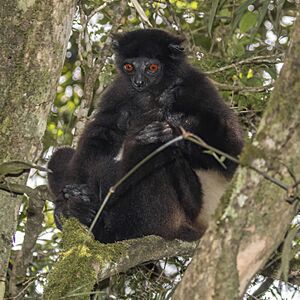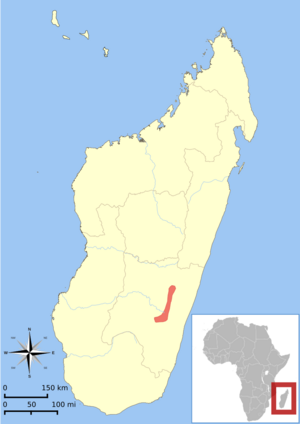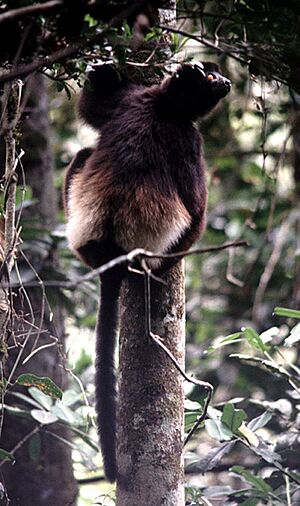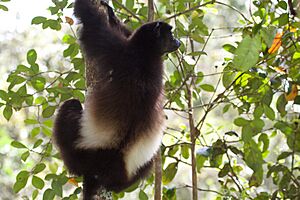Milne-Edwards's sifaka facts for kids
Quick facts for kids Milne-Edwards's sifaka |
|
|---|---|
 |
|
| In Ranomafana National Park | |
| Conservation status | |
| Scientific classification | |
 |
|
| Distribution of P. edwardsi | |
| Synonyms | |
|
The Milne-Edwards's sifaka (Propithecus edwardsi), also called the Milne-Edwards's simpona, is a large lemur that lives in trees. It is active during the day and can only be found in the eastern rainforests of Madagascar. This sifaka has a black body with a lighter "saddle" shape on its lower back. It is very similar to the diademed sifaka and was once thought to be a type of that species. Like all sifakas, it is a primate and belongs to the family called Indriidae.
This animal is named after a French zoologist, Henri Milne-Edwards (1800–1885).
Contents
Why They Need Our Help
The Milne-Edwards's sifaka is listed as an endangered species by the IUCN. This means it is at a very high risk of disappearing forever. It is also listed in CITES Appendix I, which means it is protected from international trade.
In 2008, experts believed there were about 28,600 of these sifakas left. Only about 3,500 of them lived in protected areas like national parks. Their biggest threats are losing their homes (habitat loss) and hunting. Climate change might also be a problem for them.
What They Look Like
The Milne-Edwards's sifaka is the second largest type of sifaka. It is also one of the bigger lemurs that are active during the day. On average, male sifakas weigh about 5.9 kilograms (13 pounds), and females weigh a bit more at 6.3 kilograms (13.9 pounds). Their bodies, not including their tails, are about 47.6 centimeters (18.7 inches) long for males and 47.7 centimeters (18.8 inches) for females. Their tails are almost as long as their bodies, averaging about 45.5 centimeters (17.9 inches).
This sifaka has bright orange-red eyes and a short, black face with no fur. A fluffy ring of dark fur surrounds its face. Most of its body is covered in long, silky dark brown or black fur. However, in the middle of its back, there's a brown or cream-colored patch that looks like a saddle. A dark line of fur runs down its spine, dividing this saddle patch. The exact shape and color of this saddle can be different for each sifaka. Both male and female Milne-Edwards's sifakas look very similar in size and color.
Like all lemurs, the Milne-Edwards's sifaka has special tools for grooming. It has a "toilet-claw" on its second toe and a "toothcomb" (special teeth) to help it keep its fur clean.
Their hands and feet are designed to grab things, with "thumbs" and big toes that can hold on tightly to tree trunks and branches. The pads of their fingers and toes are rough, giving them a good grip. Their nails are sharp and pointed, which helps them dig in if they start to slip. Their big toe is longer and has a deeper split than other lemurs, which helps them hold on even better.
How They Move
Living in trees means the Milne-Edwards's sifaka needs to be very coordinated and good at acrobatics. These lemurs move by "vertical clinging and leaping." This means they stay upright as they jump from tree trunk to tree trunk and move along branches. When they leap between trees, they twist their bodies 180 degrees in mid-air. This way, they are facing the tree they are landing on. They use their arms and tail to help them spin and stay steady while jumping. When they land, they swing their tail and arms downwards, much like a long-jumper, and land with their back legs first.
Milne-Edwards's sifakas can jump between 8 and 10 meters (26 to 33 feet) from one tree to another. They rarely come down from the safety of the treetops. If they have to cross an open area, like a road, they will hop sideways on two legs.
These sifakas can also hang upside down from their back legs!
Young sifakas learn to climb and leap when they are babies, venturing off their mother's back. It's normal for baby lemurs to fall sometimes, but their mother quickly helps them. Adult lemurs usually don't fall, though they might lose their grip if tree bark breaks off. Lemurs can carry food in their hands, but they usually prefer to hold it in their mouth while traveling.
Where They Live
The Milne-Edwards's sifaka lives only on the island of Madagascar, which is off the southeastern coast of Africa. They are found in both old and new rainforests in the southeastern part of the island. They live at heights between 600 and 1600 meters (1,968 and 5,249 feet). This sifaka lives further south than other types of diademed sifakas. The Mangoro and Onive rivers mark the northern edge of their home, and their southern home reaches Andringitra National Park and the Rienana River.
Their Neighbors
Several other lemur species share the same home as the Milne-Edwards's sifaka. These include:
- Eastern woolly lemur (Avahi laniger)
- Greater dwarf lemur (Cheirogaleus major)
- Aye-aye (Daubentonia madagascariensis)
- Common brown lemur (Eulemur fulvus)
- Red-bellied lemur (Eulemur rubriventer)
- Golden bamboo lemur (Hapalemur aureus)
- Eastern lesser bamboo lemur (Hapalemur griseus)
- Greater bamboo lemur (Hapalemur simus)
- Small-toothed sportive lemur (Lepilemur microdon)
- Brown mouse lemur (Microcebus rufus)
- Black-and-white ruffed lemur (Varecia variegata)
Their Daily Life and Social Habits
The Milne-Edwards's sifaka is a well-studied animal. They live in trees, are active during the day, and protect their territory. They also live in groups. Female sifakas are usually in charge of the group, which is common for lemurs but very rare in other primates.
What They Eat
Milne-Edwards's sifakas mainly eat leaves, both young and old, and seeds. They also regularly eat flowers and fruit. Sometimes, they even eat soil and underground fungi to get extra nutrients. When they are looking for food, they travel about 670 meters (2,198 feet) each day.
Social Life
Milne-Edwards's sifakas live in groups of three to nine individuals, with an average of about five sifakas per group. These groups usually have both males and females of different ages. The way the group is organized can change depending on how many males and females there are. Living in groups helps protect them from predators. However, the size of the group is limited because they have to compete for food, especially when certain foods are only available at certain times of the year. About half of the sifakas born in a group will leave it. Females usually leave when they are young, while males can leave when they are young or as adults.
Reproduction
Milne-Edwards's sifakas have one mating season each year, during the summer in the Southern Hemisphere (December and January). Females give birth during the Southern Hemisphere winter (May and July) after being pregnant for about 179 days.
Research on Sifakas
Most of the research on Milne-Edwards's sifakas happens at Ranomafana National Park in Madagascar. Many of the lemurs there wear collars, and the lead females often have a tracking device. This helps scientists learn more about them. Currently, there are no Milne-Edwards's sifakas living in zoos or other places outside of their natural habitat.
Images for kids




